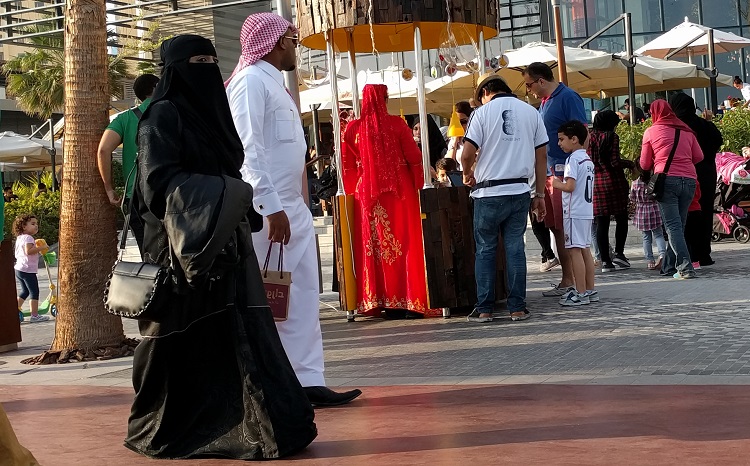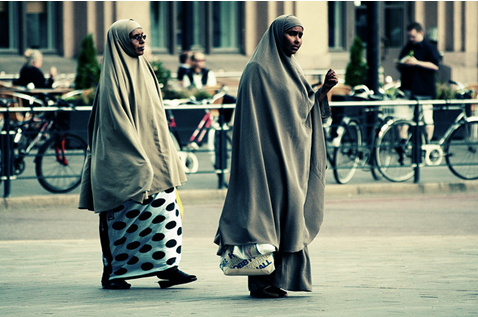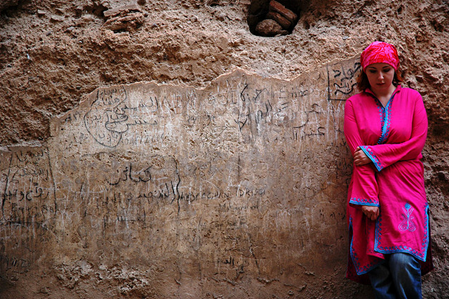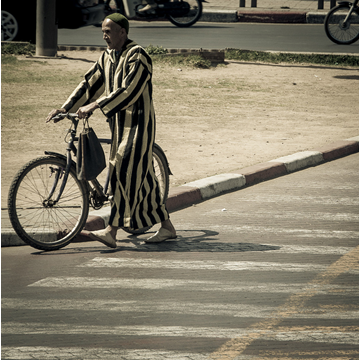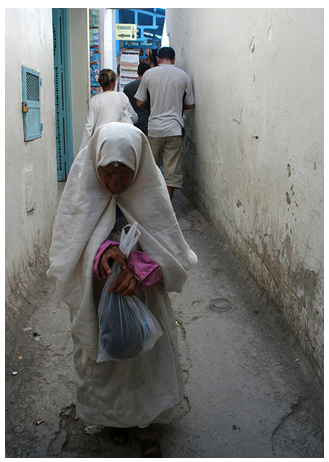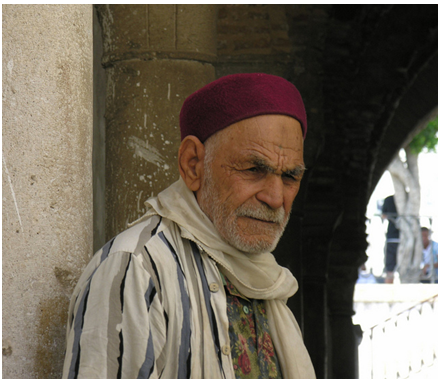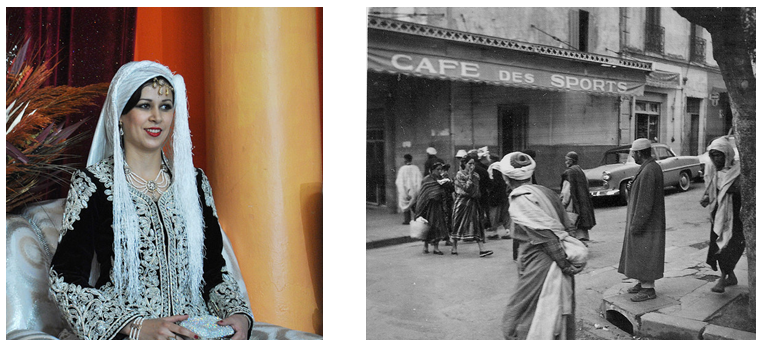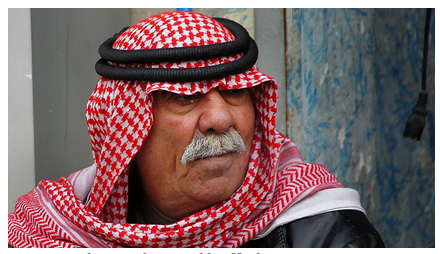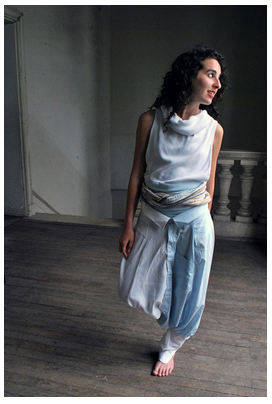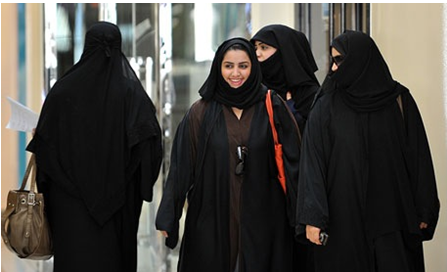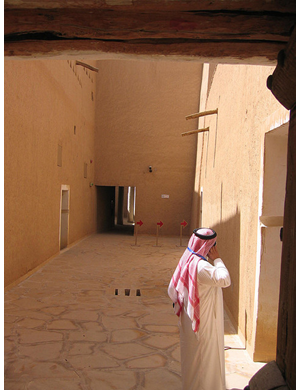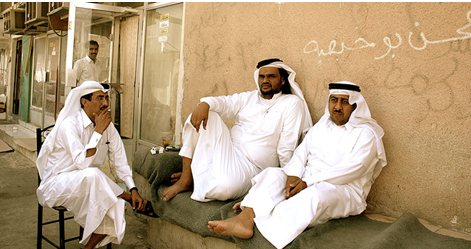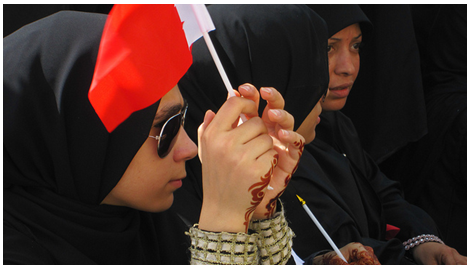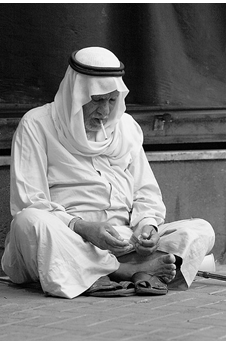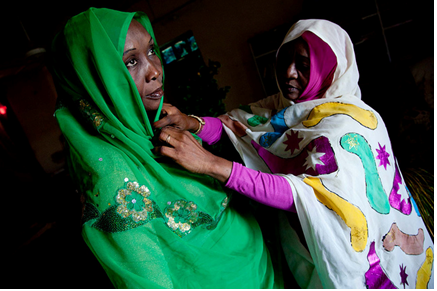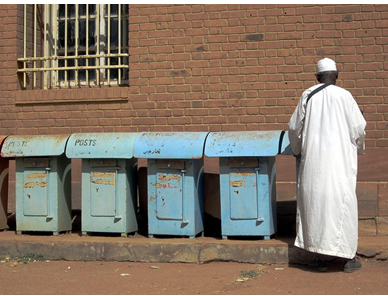Arab Clothing: The Ultimate Guide
The Middle East is a variegated and colourful universe when it comes to clothes and attires for both men and women. It is a complex reality where local traditions and Western fashion mix. While the latter has deeply influenced Arab countries, it is still possible to spot some traditional garments.
In this guide we will first deal with some of the most common stereotypes about Arabs and clothing, then consider the traditional garments worn in different countries, starting from Morocco down to Oman and understand how the concept of “modest dress” drastically changes from one country to another within the region. Finally, you will have the opportunity to test how much you remember about Arab clothes with a quick quiz.
If white robes and black veils are the only things that pop in your mind when you think about Middle Eastern clothes, then you should really read on…
DETERMINING FACTORS: AGE, LOCATION AND SOCIAL CLASS
Age and location make a big difference when it comes to clothing in the Middle East. On the one hand, younger people tend to wear Western clothes and use their traditional outfits only for special occasions such as weddings, religious celebrations or a pilgrimage, while the older generations are more easily seen with traditional garments.
On the other hand, people living in the cities are more attentive to the latest fashion trends, while in smaller towns and rural contexts men and women still prefer traditional attires because of their comfort and the protection they offer from the sun, the wind and the sand.
A third factor could be social class. On the one hand, designer clothes from the West are very popular among the middle and upper class, while traditional garments and more conservative attires might be more easily found in popular neighbourhoods. While this could be true for certain countries in the Levant and North Africa, the criteria most definitely change for Gulf countries where all women and men wear similar clothes and it is actually the quality and design of the abaya, an expensive bag, or a pair of sunglasses to reveal the social class of the wearer.
STEREOTYPES
Before analyzing which clothes belong to which country we must clarify some general misconceptions related to Middle Eastern clothing, as well as introducing the basic terms of Arab fashion.
1) All Arab women wear hijab.
NO. This statement is wrong for two main reasons:
a. some Muslim women decide to wear a hijab and some let their hair uncovered
b. some Arab women are Christian or Jewish and thus might not follow the same clothing rules
2) The hijab is a headscarf.
YES. The term hijab is commonly used to refer to the headscarf worn by many Muslim women.
But the word hijab does not only refer to the short veil wrapped around a woman’s head. Hijab is in fact also a general term for modest attires which include head covering.
3) There is only one kind of veil.
NO. The term veil includes a notable variety of headgears which come in a multitude of shapes, lengths, and fabrics.
There are different kinds of veils and women wear them not only as a religious or cultural sign of belonging to a certain society, but also consider them an important fashion statement. Hijabs have different styles and colours and women wearing a hijab (muhajjabat in Arabic) are always up to date with the latest trends, just as Western women know whether an item is out-dated or not.
A clear instance of how hijab fashion changes and evolves is the so-called “Gamboo’a”, literally “Camel hump”. It was really fashionable around 2008 when women sported voluminous hijabs using a clip with a huge plastic flower (the gamboo’a) under the headscarf. It soon became very popular, especially in the trendsetter country of the region: the UAE. However, by 2011 it was already considered out of fashion.
Here are the four main types of hijabs:
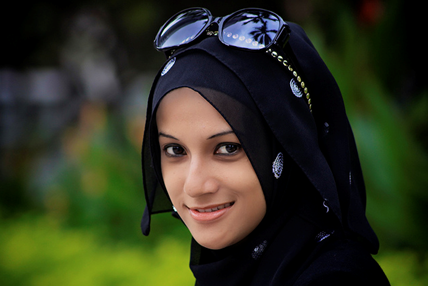
Photo credit: Faizal Riza MOHD RAF
1. SHAYLA: it is a one-piece veil. A long scarf that is wrapped around the head, pinned under the chin and gently rests on the shoulders. It is usually worn on top of a cap of a matching colour, which helps to keep the hijab in place. The rim of the cap may or may not be shown according to the woman’s preference.
It is the most common kind of hijab, particularly in the Gulf countries (with the exception of Saudi Arabia)
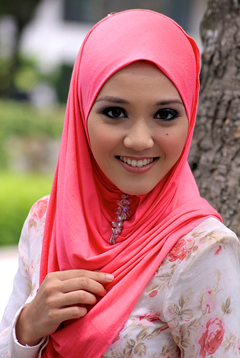
Photo credit: Faizal Riza MOHD RAF
2. AL-AMIRA: a two-piece veil. It is very easy to wear and it is made of a head cap and a tubular scarf worn on top of it. The main difference between Shayla and Al-Amira is the shape of the scarf (rectangular for the shayla, tubular for the al-amira) and the head cap (hidden or only slightly visible in the former, while a big portion is left exposed in the latter)
It can be seen in the Middle East, even though it is particularly widespread in the South East Asian Muslim community.
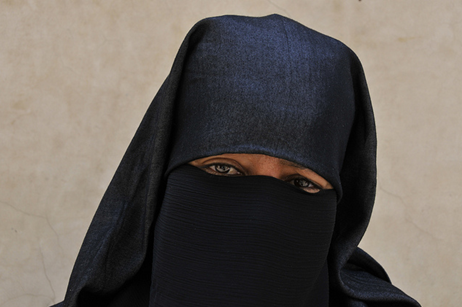
Photo credit: POTIER Jean-Louis
3. NIQAB: a face veil which is usually worn with a headscarf and tied behind the head. It leaves a gap for the eyes only, even though some women add an eye veil which allows them to see without revealing their eyes.
It is not unusual to see a niqab in North Africa or the Levant, but it is most commonly used in Saudi Arabia
4. KHIMAR: is a long veil that covers the head and the chest till the waist. The face is left uncovered.
It is not as popular as the previous types of head covering; still, some women wear it in their daily life.
Photo credit: J McDowell
4) Some Arab women wear a burqa.
NO, generally speaking. This is an item characteristic of Pakistan and Afghanistan and was imposed by the Taliban and it is not paramount in the Arab world, even though some countries such as Yemen have their own version of the burqa (or burghaa) which differs from the Afghan one.
It is not to be confused with the niqab, which is indeed commonly used in the Middle East. The differences:
- The niqab is usually black and merely a face veil, the burqa is mostly light blue in colour and covers the whole body
- The niqab usually leaves the eyes uncovered, while the burqa has a net over them
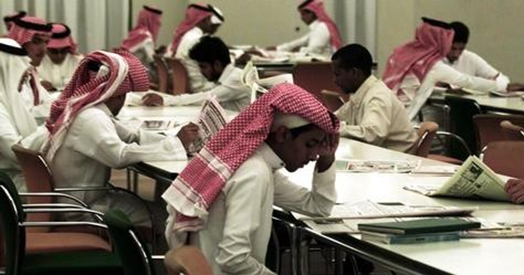
Photo credit:Tribes of the World
5) All Arab men wear a long, white robe and a coloured headscarf.
NO. Only men in the Gulf are used to daily wear the headscarf and the white robe. The headscarf (ghuthrain the Gulf, keffiah in the Levant) is tied on the head with a black piece of cord (aghal) and is used with a skullcap called thagiyah which keeps the hair in place.
The white robe, called thoub/thobe, dishdasha or kandora, is the main item of clothing for Gulf men and is generally worn with a pair of loose-fitting trousers called sirwal, either long or short. While the keffiah is also used in Palestine and Jordan, the dishdasha remains the landmark of Gulf men’s fashion.
A POLL TO GIVE US A GENERAL OVERVIEW
Among one of the most interesting surveys about clothes ever conducted in the region is the following one, conducted by the University of Michigan’s Institute for Social Research. It shows how the perception of decency and modest clothing dramatically changes from one country to the other within the Middle East.
Most of the times we will see how these opinions are then reflected in the way Arabs dress. For example, it is indeed true that many women in Lebanon do not cover their hair, on the contrary, the majority of women in Saudi Arabia wear a niqab.
You find further information about the poll here: http://pewrsr.ch/KEyUvb
DIFFERENT FOLKS, DIFFERENT STROKES
Now that we have some basic vocabulary related to men’s and women’s fashion in the Arab world, it is time to see what their attire can tell us about the country of origin and, in some cases, their social class, too.
We can identify 4 main areas when it comes to clothes: North Africa, the Levant, the Gulf, and finally, Sudan.
NORTH AFRICA
Walking through the streets of Rabat or Tunis we see many men and women donning Western clothes. So how can we tell if they are actually Moroccan or Tunisian, only by the way they are dressed?
It is actually quite straightforward once we identify those robes or head gears that are unique to that country.
Morocco
Many Moroccans still wear the djellaba, a wide and comfortable hooded tunic with long sleeves which can be considered as a part of the national heritage. They are more colourful for women, while they are made in earth tones for men.
Moroccans might accompany the tunic with the traditional slippers called balgha, which come mostly in yellow, but other colours are used, too.
MORROCAN WOMEN’S CLOTHING
Kaftan: an overdress similar to the djellaba but without a hood. It is usually worn on festive occasions or weddings, it is not used in daily life.
A kaftan. Photo credit: Alice
MOROCCAN MEN’S CLOTHING
Gandora: a short-sleeved robe, lighter than the djellaba
An example of djellaba. Photo credit: ukg.photographer
Tunisia
Spotting a traditional outfit in Tunisia may be quite challenging, especially in the cities. But a trip to the medina in Tunis or attending a marriage could give you a chance to admire the beauty of Tunisian traditional clothes.
The two most representative items are:
TUNISIAN WOMEN’S CLOTHING
Sefsari: while it is rarely worn, there are indeed some elderly women that still use this long, white veil. Head for the old part of Tunis if you want to see one
TUNISIAN MEN’S CLOTHING
Chachia: some older men still wear this flat red hat made of wool. It is a symbol of the Tunisian traditions
Old woman wearing a sefsari in Tunis. Photo credit: Nevenka Mazic
Old man wearing the chechia, Tunis. Photo credit: Andrea Nardi
Algeria
Much like Tunisia, Algeria has also been heavily influenced by the West when it comes to clothes, thus seeing a typical Algerian attire might be difficult. Elderly men and women are most likely to wear these two typical items of clothing:
ALGERIAN WOMEN’S CLOTHING
Karakou: Algerian women love colours and embroideries. This traditional embroidered jacket has made its big return on the Algerian fashion scene and is now used on important occasions and weddings.
ALGERIAN MEN’S CLOTHING
Gandora: it is typical of Algeria too, but usually made of brown or white wool
Woman wearing the Algerian karakou Algerian men wearing gandora,1955
Photo credit: Nejma Rondeleux Photo credit: phlubdr
Libya
Young Libyans normally don jeans and t-shirts. However, it is sufficient to leave the city and approach the rural areas inhabited by the Berbers to see the original Libyan attire.
LIBYAN WOMEN’S CLOTHING
Haik: this veil, almost forgotten in Algeria, is still worn by some Libyan Berber women, as well as Moroccan. It is a long white piece of cloth which covers the whole body
Holi:a white cloak wrapped around the body, usually worn with the tagiyah
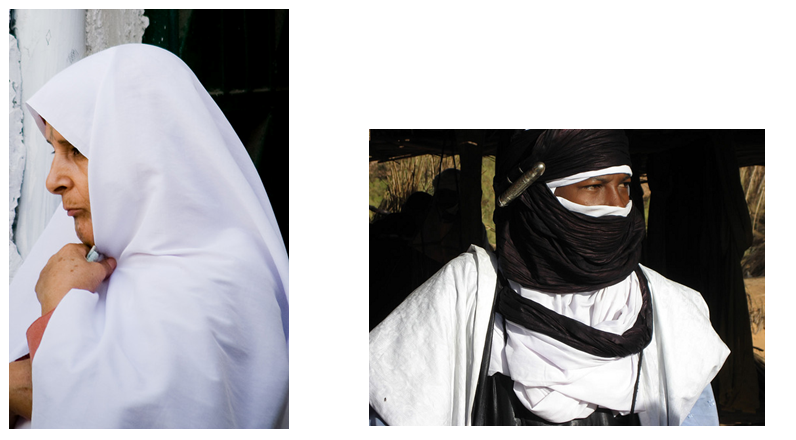
A Libyan woman wearing a haik in Tripoli A Libyan Touareg donning a holi
Photo credit: C. Mario del Río Photo credit: David Stanley
Egypt
Walking through Cairo means observing a wide range of clothes and attires: from women wearing a niqab, through hijabi girls and up to ladies who don’t cover their hair at all. Men’s clothing doesn’t tend to be as varied since polo shirts and jeans are worn by most male Egyptians. This notwithstanding, the inhabitants of some peripheral area of Cairo, as well as the great majority of the so called fellahin (farmers) still prefer more traditional and airy attires.
EGYPTIAN WOMEN’S CLOTHING
Gallabya: much like the djellaba and the gandoura, the gallabya is also a long tunic without buttons or a proper neck. It comes in colourful and embroidered variations for women and in neutral colours for men.
EGYPTIAN MEN’S CLOTHING
Taqiya: this skullcap is usually worn under the ghuthra (men’s headscarf) in the Gulf and the Levant as well. The particularity of Egypt is that some men were this cap on its own
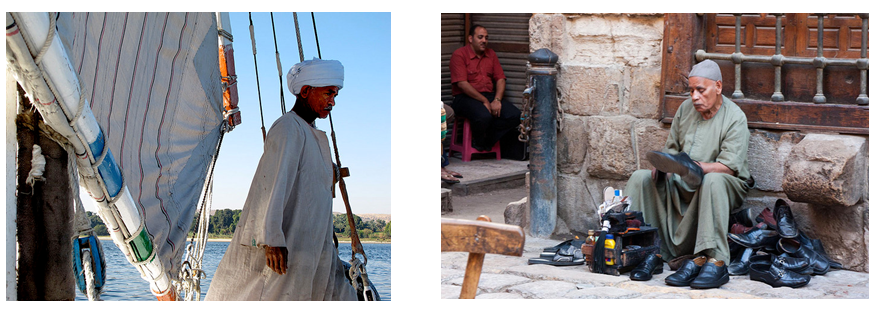
Egyptian sailor wearing a gallabiya Man in Cairo donning gallabiya and taqiya.
Photo credit: Mindy McAdams Photo credit: Héctor de Pereda
THE LEVANT
Similarly to the countries in the Maghreb, Western clothes are predominant also in the Levant, especially in big cities such as Beirut or Damascus. However, there are also many local garments and attires that can be seen in the cities themselves, as well as the countryside.
We have shown that all the countries in al-Maghreb have some items of clothing in common such as the gandura or the barnous, a hooded djellaba. The same is true for the Levant. Nonetheless, there are always some particular headgears or tunics which are unique to a certain country.
Jordan
Niqab, hijab, jilbab, jeans, t-shirts, khimar: these are only a part of the vast array of clothes worn by Jordanians. While in the western part of the capital Amman, Western-style clothes are widespread; it is common to see more traditional and conservative attires in the area of downtown and eastern Amman, as well as in smaller towns.
The following garment is a symbol of the Jordanian heritage and values:
JORDANIAN MEN’S CLOTHING
Shemagh mhadab: this red checked keffieh is widespread in the Gulf, too, especially in Saudi Arabia. It is the colour that is typical of Jordan as it stands for the values of the Bedouin culture: the bigger the tassels, the higher the importance of the wearer.
Man sporting the traditional keffieh in Amman. Photo credit: Steve Evans
Palestine
Like Jordan the beauty of traditional Palestinian clothes has almost been forgotten, as most people in cities such as Ramallah or Jerusalem wear jeans and t-shirts if they are men; jilbabs, Western clothes and hijab if women.
However, there is one headgear which has come to represent this country, especially thanks to Yasser Arafat:
PALESTINIAN MEN’S CLOTHING
Black and white keffieh: this colour pattern has always been unique to Palestine and it even became a fashionable item in America and Europe in the early 2000s. Nowadays it still represents support for the Palestinian cause
Old man wearing the Palestinian keffieh in Gaza. Photo credit: Grassroots International
Lebanon
Among all the Arab countries Lebanon probably deserves the title of most fashionable and stylish. A large number of women decide not to wear a hijab, especially in the capital Beirut. Try your luck and see if you can spot some Lebanese still wearing this traditional garment:
LEBANESE MEN’S AND WOMEN’S CLOTHING
Sherwal: these baggy and comfortable trousers are also commonly seen in the Gulf under a dishdasha. They are one of the few traditional garments still worn by some Lebanese countrymen. They are used on their own, no thobe needed. They have also been recently reinvented in a more fashionable female version.
Example of modern-day sherwal. Photo credit: RE-act Atelier Boutique Nantes
Syria
Much like the other Levantinian countries, Syria has seen more and more men and women opting for Western-style clothes. The majority of women wear a hijab and some sport a jilbab or even an abaya and niqab, while some older men can still be seen with keffieh and long tunics.
Traditional clothes were once famous for the quality of their fabrics and the beauty of their embroideries, often in black and red. However, they have basically disappeared from urban areas and are worn in the countryside only on special occasions.
SYRIAN WOMEN’S CLOTHING
Thob: differently from the Gulf, this is considered a female garment in Syria. It is dyed black and red and often accompanied by a belt of the same color
SYRIAN MEN’S CLOTHING
Sirwal: just like Lebanon, these trousers cannot miss from any traditional attire. They are long, loose and come in black or neutral colours
Jordanian and Syrian thobes share the same colours: red and black. A group of Syrian men wearing their traditional clothes
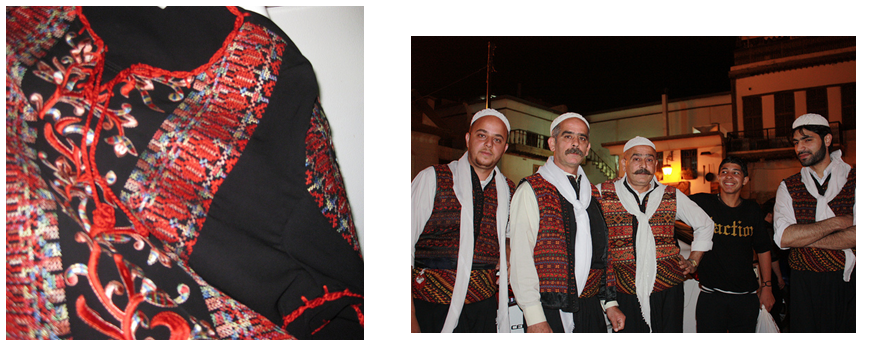 Photo credit: Ruby Goes Photo credit: Arian Zwegers
Photo credit: Ruby Goes Photo credit: Arian Zwegers
THE GULF
When it comes to the Gulf it is pretty easy to spot its citizens as, differently from most other countries in the region, they have kept wearing their traditional clothes.
All men in the Gulf usually use a long, white tunic called dishdasha which helps keep the body cool in the heat of the region. This tunic is usually worn with short sherwal trousers and a ghuthra, alight, white headscarf or the keffieh, in the colder season.
Women wear wide, long robes called abayas, usually in association with a shayla hijab that shows some hair and a niqab.
Even if the thobes for the men and the abaya for the women may seem the same everywhere in the region, there are actually some small details that allow us to understand whether we are talking to a Qatari, a Kuwaiti or an Omani.
Some have commented that the loose-fitting nature of the abaya and the dishdasha make it easier to put on excess weight without it noticing it. As fast food in the region has increased, obesity has become a major issue leading some to seek out procedures like gastric sleeve surgery to address the issue. Though no one likely goes from healthy to obese without noticing it, it is likely that loose-fitting clothing makes the consequences of gaining a few extra kilos less visible.
Saudi Arabia
Saudi men and women have kept wearing their traditional items of clothing and adherence to the moderate Islamic dress for both sexes is an absolute must. Most people wear the following:
SAUDI WOMEN’S CLOTHING
Niqab: if niqabs are sometimes seen in the Levant and North Africa, they become predominant in Saudi Arabia, where only some cities like Jeddah and Dammam accept women walking around without the face veil
Gloves: it is not uncommon to see women wearing black gloves covering their hands and arms
SAUDI MEN’S CLOTHING
Shumagh: it is the Saudi name for the typical Jordanian keffiah which is worn by many Saudis in winter to replace the ghuthra
Dishdasha: the typical Saudi thobe resembles a long shirt. It has a two buttoned neck, it is tight and made to have cufflinks (kabak)
Saudi women walking in a shopping centre in Riyadh. Photo credit: Tribes of the World
Saudi man on the phone. Photo credit: Cary Bazalgette
Qatar
Even if only 25% of the 2.1 million inhabitants have actually Qatari origins, there is a very strong national identity which is expressed through clothes, as well. Qatari fashion is similar to the Saudi Arabian one, but it is more colourful, especially on the women’s side.
The most common garments are:
QATARI WOMEN’S CLOTHING
Al-darraa: some women wear this local version of the black abaya
QATARI MEN’S CLOTHING
Shumagh: the Qatari shumagh is typically white and has an African taste to it with two tails on the back, stiff in the front part, it resembles a cobra snake
Dishdasha: the Qatari dishdasha comes in shiny fabrics and usually has a pocket
3 women at the Museum of Islamic Art, Doha. Photo credit: Kevin Burden
3 Qatari men relax in Doha. Photo credit: Jabiz Raisdana
Kuwait
The 1.4 million Kuwaitis really differentiate themselves from the 2.3 million expats that also live in Kuwait and not only because of the language they speak, but above all because of the way they dress. Here are the typical Kuwaiti garments:
KUWAITI WOMEN’S CLOTHING
Dara’a: the name is the same as the Qatari dress, but it comes in a more colourful version and different models. It is usually used for weddings, traditional dances and so on
KUWAITI MEN’S CLOTHING
Shumagh: the Kuwaiti shumagh is predominantly white and characterised by a scale shape when observed from the front
Dishdasha: the Kuwaiti dishdasha has a distinguishing one button collar
Kuwaiti women waiting to vote in 2012 Kuwaitis in a political rally in 2012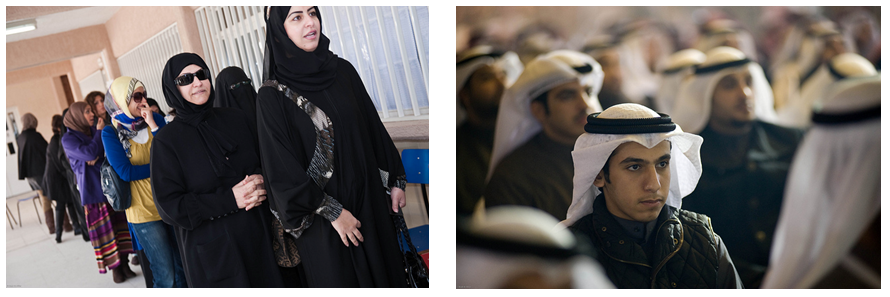 Photo credit: Kuwaitelections2012 Photo credit: Kuwaitelections2012
Photo credit: Kuwaitelections2012 Photo credit: Kuwaitelections2012
Bahrain
Bahrain might not be as big as Saudi Arabia, but it has certainly nothing left to be desired when it comes to history, biodiversity and, of course, clothes. Their traditional clothes are in line with the other Gulf countries but have some special features which differentiate them.
BAHRANI WOMEN’S CLOTHING
Abaya: lookout for red abayas with golden embroideries because they are only worn on special occasions
Red: is the national colour and it is not unusual to see women wearing accessories of this colour on important days
BAHRANI MEN’S CLOTHING
Shumagh: white is the most widespread colour. Worn loose, it lets the head move freely
Dishdasha: also the Bahraini thobe is very comfortable, loose and witha shirt collar
Young woman in Manama. Photo credit: Al Jazeera English
Old man smoking in the capital. Photo credit: Hussain Isa Alderazi
UAE
The UAE has a complex fashion panorama. While Dubai is the most progressive and up-to-date among the emirates, the other areas are more conservative in terms of clothing.
Fashion here has evolved incredibly fast and if in the past sirwal and burqa were a must for women, they have been substituted by the abaya and even the white thobe now comes in a variety of colours.
EMIRATI WOMEN’S CLOTHING
Abaya: Dubai is the land of fashionable and trendy abayas decorated with sequins, embroideries and ribbons
EMIRATI MEN’S CLOTHING
Shumagh: white or in the Jordanian red and white pattern. Very simply styled and left loose over the shoulders
Kandora: the UAE name for dishdasha. It is collarless and features a long tassel called tarboosh
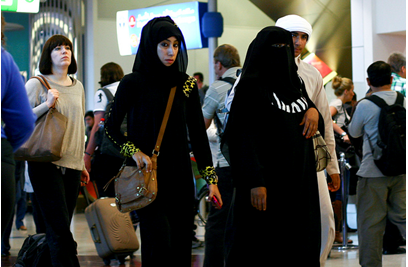
Emirati women in Dubai airport. Photo credit: Nicolas Mirguet
Emiratis attend a military parade in Abu Dhabi Photo credit: Tribes of the World
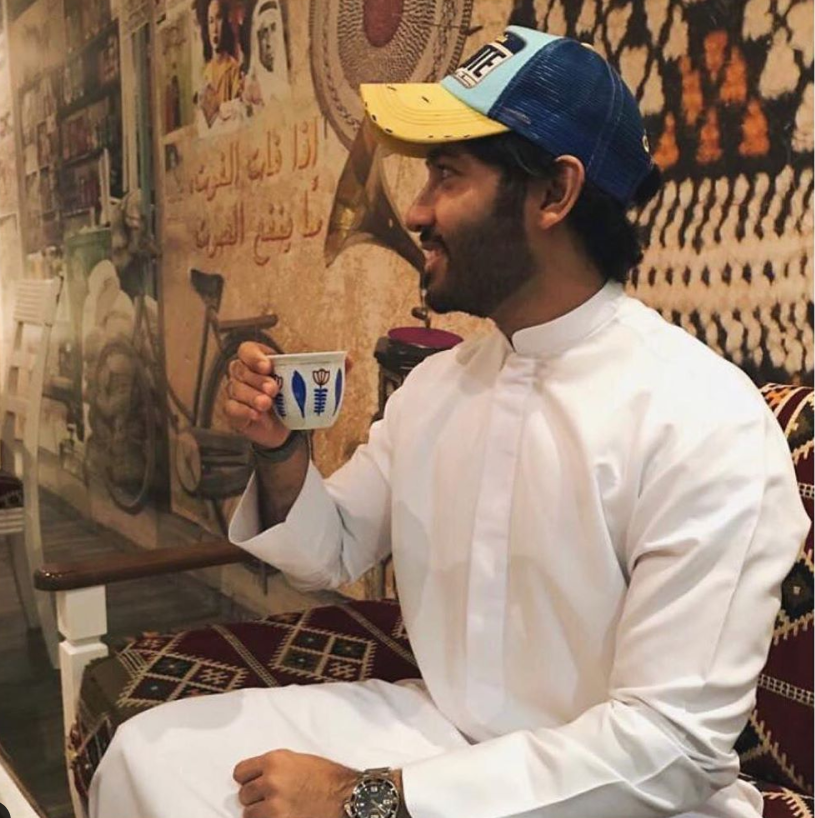
In recent years it has become fashionable for men in the UAE to wear an American style baseball hat or trucker hat with their white or brown Kandora.
Oman
The southern sultanate really cares about the integrity of its national heritage, clothing included. That’s why traditional dress is compulsory for all employees in the public sector in Oman. Western-style clothes have no space in the country, with the exception of tourists of course.
Traditional Omani attires could not be complete without:
OMANI WOMEN’S CLOTHING
Abaya: the black abaya with some colourful details is most common in the capital Masqat
Dishdasha: just like men, also Omani women of rural areas wear this traditional tunic in a great variety of colours and with rich details. They match it with loose-fitting sirwals.
Lahaf: a common headscarf wrapped around the head
OMANI MEN’S CLOTHING
Kumma: there is no space for the shumagh in Oman, substituted by the traditional cap which comes in different colours and has holes to keep the head cool
Muzzar: a turban which is wrapped around the head, with or without kumma underneath it
Dishdasha: it can be white or in earth tones such as brown or grey. It sports a short tassel, too
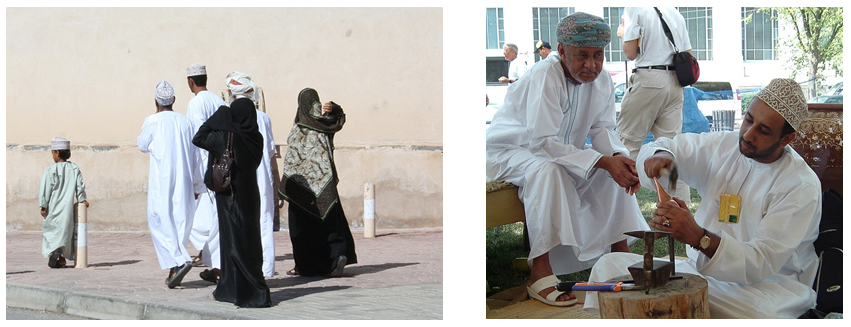 Omani family in Nizwa. Photo credit: ~W~ Two Omanis at work. Photo credit: ophiuchus1
Omani family in Nizwa. Photo credit: ~W~ Two Omanis at work. Photo credit: ophiuchus1
Yemen
This country has preserved an extraordinary heritage in terms of history and traditions. Clothes are just one expression of how much Yemenis still follow their customs and their outfits show the region they come from: the mountainous North, the coastal area of the West and South or a tribal area. Still, it is not uncommon for men to wear Western clothes in the cities.
This is what makes their attires different from all the other Gulf countries:
YEMENI WOMEN’S CLOTHING
Balto: it is the Yemeni version of theabaya.It is widespread in the urban areas
Lithma: more or less the Yemeni version of the niqab
Sitara: literally “curtain”, is the traditional dress of the capital Sana’a. Nowadays, only elderly women wear this colourful piece of cloth which covers them from head to toes
YEMENI MEN’S CLOTHING
Shawl: this headscarf, differently from the shumagh, is wrapped around the head just like a turban. It comes in many different colours
Thobe: while the white thobe is very common in the North of the country, all men of the coastal areas wear a skirt called futa’
Jambiya: it is not unusual to see this dagger hanging from men’s belts, especially in the northern areas. The more valuable ones have been used by the same family for generations. There are also cheaper daggers manufactured in China
 Yemeni woman wearing a Sitara. Photo credit:fiat.luxury Men from the city of Amran. Photo credit: fiat.luxury
Yemeni woman wearing a Sitara. Photo credit:fiat.luxury Men from the city of Amran. Photo credit: fiat.luxury
SUDAN
The style of Sudan is unique and easily recognisable. Sudanese wear many of the garments which are widespread in the rest of the Middle East, but in a brighter and more colourful version which reminds us of other African countries.
While Western clothes are indeed used especially in the cities, some still prefer the loose-fitting traditional items.
Let’s see what items of clothing you cannot miss if visiting Sudan:
SUDANESE WOMEN’S CLOTHING
Thobe: differently from the Gulf, this big piece of cloth is an item for women. It is wrapped all around the body and the head. It comes in varying patterns and colours, according to the occasion. It is generally donned by older women. Alternatives are: abayas, long skirts, and dresses
Hijab: being a Muslim country, all Sudanese women wear a headscarf, sometimes underneath the thobe
YEMENI MEN’S CLOTHING
Jalabiya: just like the Egyptians, also Sudanese men like being comfortable wearing this loose-fitting tunic. They usually add a decorated scarf called an immah
Taqiya: the skullcap is worn without the keffieh to keep the head cool, again just like Egypt
Two examples of colour Sudanese thobe. Photo credit: UNAMID
Sudanese man wearing a jalabiya in the capital Khartoum. Photo credit: David Stanley
Arab Traditional Clothing: Side by Side Comparisons
Throughout the Middle East, women’s and men’s clothing varies greatly but shares some fundamental elements. For Arab men, the two staples of traditional clothing are the thobe and the headdress or cap. In fact, the Arabic term thobe just translates to fabric, so it’s not surprising that many countries have adopted their own specific terms to refer to this traditional dress.
Let’s take a look at some Middle Eastern countries’ traditional thobes and headdresses to compare across the region. As we mentioned above, some regions such as the Levant and the Maghreb tend more towards Western fashion, whereas the Gulf prefers traditional clothing, and tend to have more standard styles that denote the wearer’s origin.
GULF REGION
Saudi Arabia
The traditional men’s thobe is usually white and features a simple, straight collar with buttons and cufflinks at the end of the sleeves. As for the headdress, Saudi men tend to wear a red and white cotton keffiyeh, called a shumagh, held in place by a fabric loop called the agal.
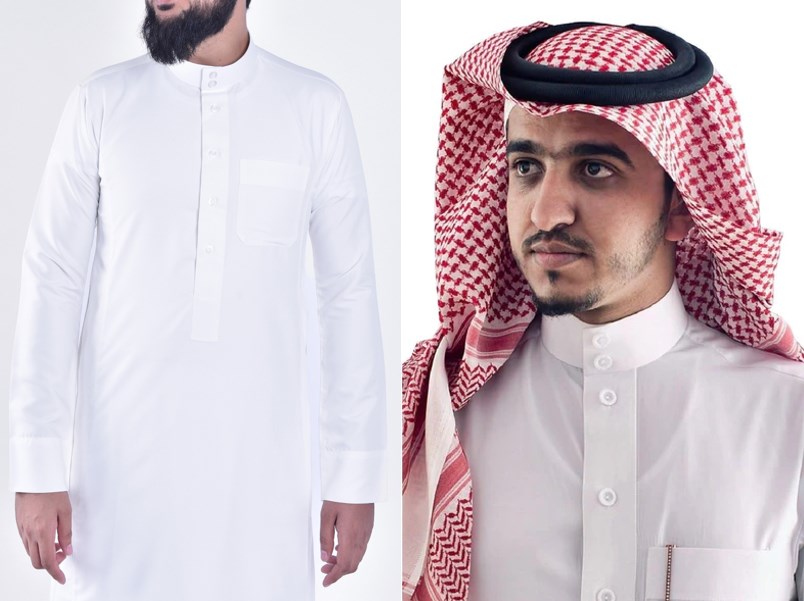
United Arab Emirates
Emirati men wear a long robe called a kandura, which traditionally has no collar and a small cord down the front, and can be seen in varieties of brown, gray, and beige in addition to white. Emirati men wear a headdress called a ghuthra which consists of a folded white cloth or keffiyeh held in place by an agal. Emirati agals are unique as they have two cords hanging from them called tarboush.
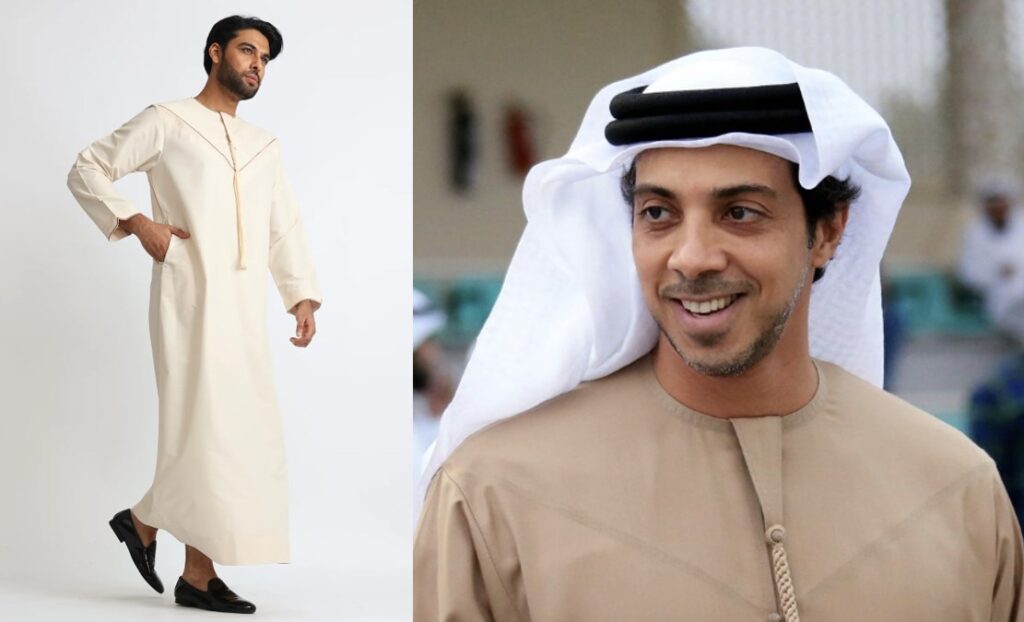
Oman
Omani men wear a long dress called a dishdasha which features bright colors, an embroidered ring around the neck, and threads hanging from the chest. On their head, Omanis wear a colorful massar, which is sometimes accompanied by a circular two-piece cap called the kumma.
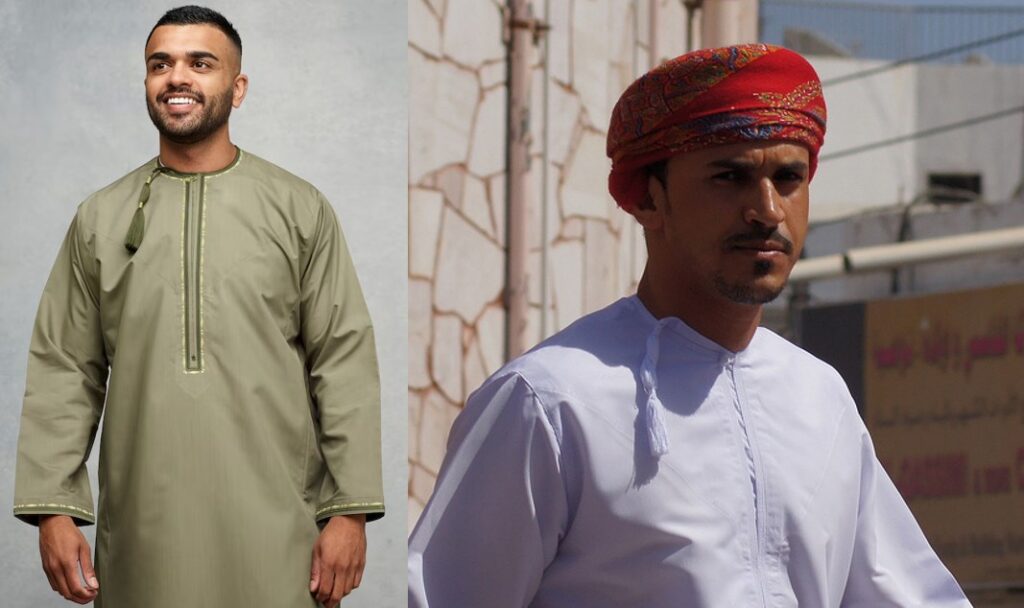
Kuwait
Kuwaiti men wear a simple thobe with a one-button collar usually in white. Their traditional headdress is similar to the Saudi Arabian style, consisting of a white shumagh or red and white keffiyeh held in place by an agal.

Bahrain
Bahraini men typically wear a white thobe with a one-button collar left open at the top. Their headdress consists of a cotton square scarf called shemagh or ghuthra held in place by a black agal. Like in the other Gulf countries, some men opt for the traditional white ghutrah while others use the keffiyeh.
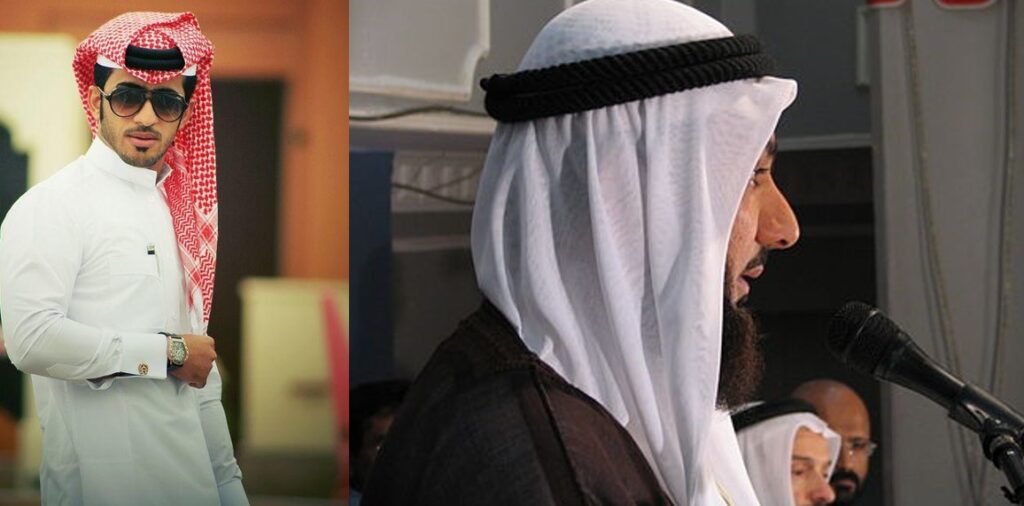
Qatar
Qatari men wear a white thobe or qamees with a prominent collar, usually over loose white pants. On their head, they wear a ghuthra that is folded in a unique style, as pictured below.
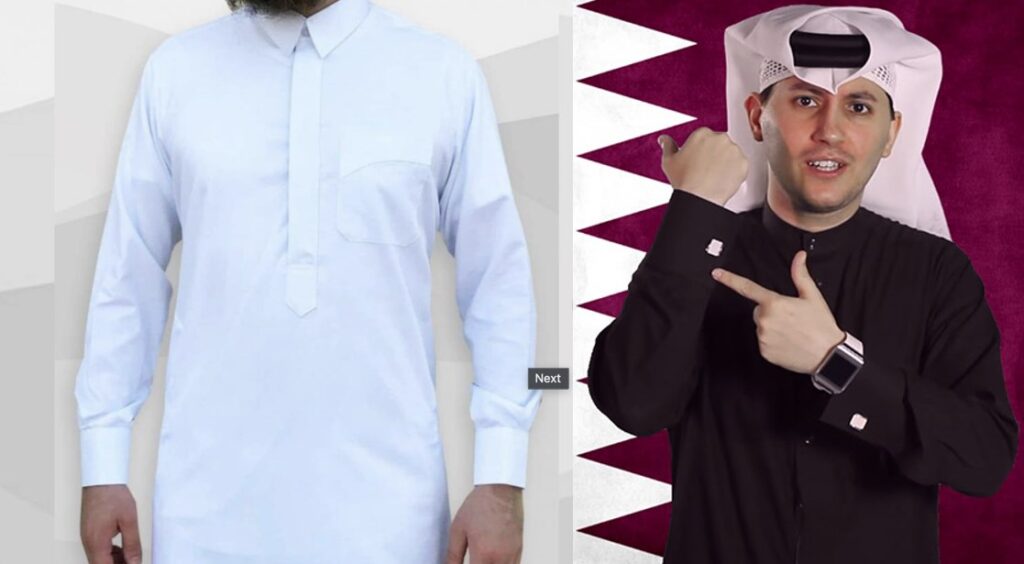
Yemen
Similar to neighboring Oman, Yemeni men typically wear a long white dishdasha with a blazer style overcoat. In more formal contexts, a colorful belt holding a dagger is traditional along with the dishdasha. The headdresses range from more Saudi-like keffiyehs and shumaghs to Omani massar turbans.
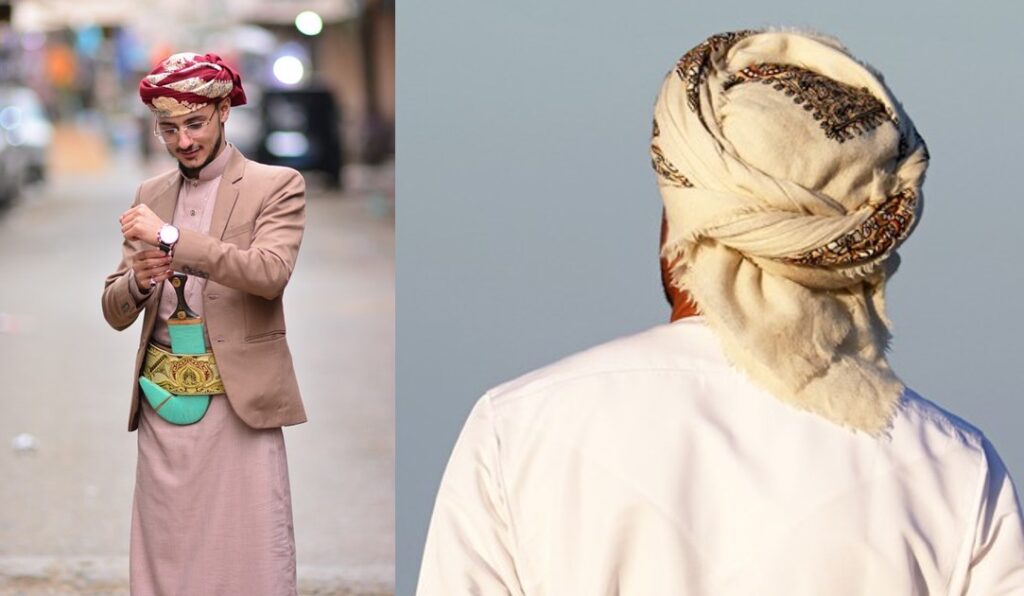
LEVANT REGION
The Levant countries of Jordan, Syria, Palestine, and Lebanon have traditional clothing styles, but they aren’t usually worn on a daily basis like in the Gulf. The same goes for Iraq, which is not usually grouped with the Levant countries but also has shifted from more traditional clothing to Western styles. One uniting element of traditional men’s dress is the keffiyeh – the distinctive checkered red and white or black and white headscarf. See below for images of traditional men’s dress throughout the Levant.
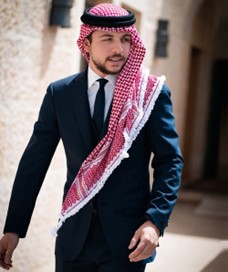
Jordan
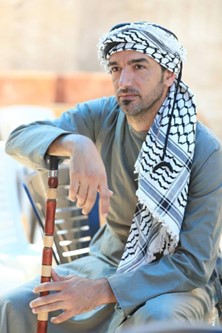
Palestine
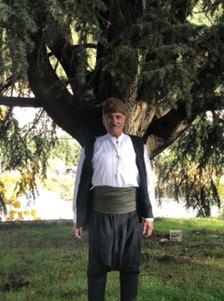
Lebanon
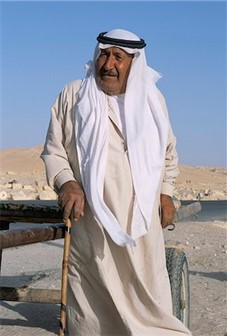
Syria
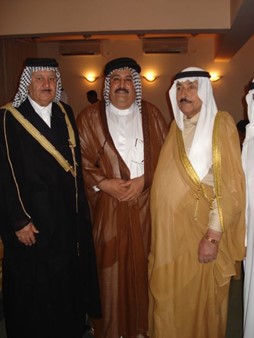
Iraq
NORTH AFRICA / THE MAGHREB
Egypt, Libya, Sudan, Tunisia, Algeria, and Morocco: each have their own traditional clothing styles, but today these are mainly only worn for special occasions like weddings or holidays. That being said, notably in Morocco, Egypt, and Sudan, there are some traditional mens’ clothing items that are commonly worn on a daily basis.
Morocco
Men in Morocco opt for comfy, loose fitting jellabas for formal and informal contexts alike. These long robes come in a variety of colors, often having embroidery around the neck and a wide hood.
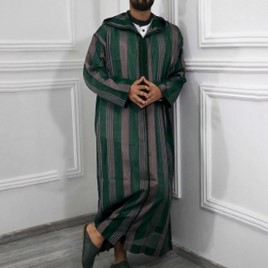
Egypt/Sudan
Egyptian and Sudanese men wear gelabeyas – which in fact is the same word as jellaba – just in Egyptian Arabic. Compared to Moroccan jellabas, these tend to feature more muted colors as well as a collar.
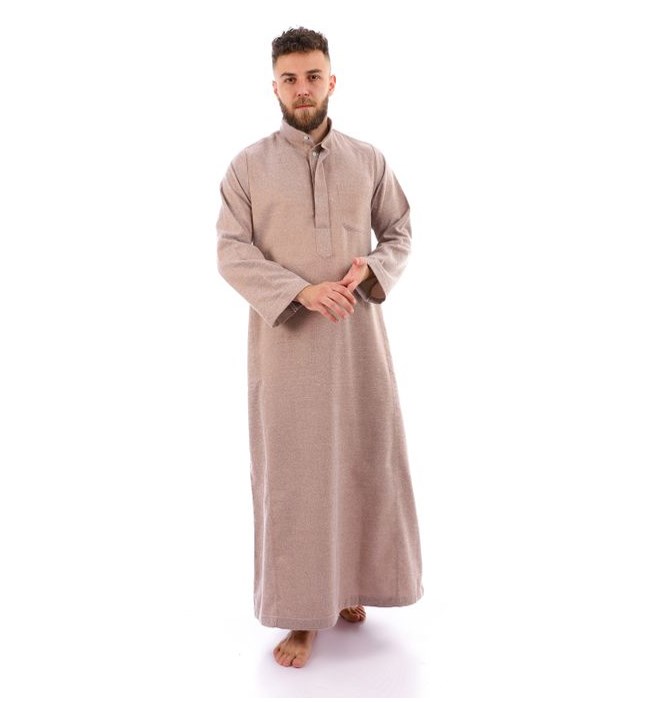
ARAB MEN’S CLOTHING: RECAP
In this section, we took a more in-depth look at Arab men’s dresses, particularly in the Gulf Region where they are most prevalent. This side-by-side comparison is helpful, as identifying these subtle differences can indicate the country of origin of the wearer.
Ready to test your knowledge of Arab clothing? Take our Arab clothing quiz here.
TO SUM UP…
Clothing in the Middle East is an important business, perhaps even more than in the West. Clothes reveal so many things about not only the personality, but also the region and social class of the wearer. Moreover, the choice of a certain item of clothing assumes a fundamental moral value. For example, some Arabs more or less consciously think that women without hijabs are more open minded, but also have fewer morals, while women with hijab are somewhat more religious and thus respectable. Thus, clothes in the Middle East are a fashion statement, just like they are in the West, but clothing has a stronger social and moral dimension, too.
As we have seen there is an infinite variety of Arab garments and what we have listed represents only a minimum part of it. Clothes remain a fundamental element in the cultural identity of each country in the Middle East. Some countries have followed Western footsteps in terms of fashion, namely the Levant and North Africa, while others are still holding on tight to their traditional attires like Saudi Arabia or Yemen.
While clothing might seem a superficial matter in Europe and America, this really is not the case in the Middle East. Clothes can give us precious info about the person in front of us while we are doing business or making friends and it is a useful key to understand the spirit of each Arab nation.
About IstiZada
IstiZada regularly creates resources that are free to the public with the goal of building bridges with the Arab world through education. Years ago we saw that there was a lack of good information available online about various aspects of Arab culture in English. Ever since then we’ve been creating free resources that our researchers and writers take weeks and sometimes months to research and write. IstiZada is also a company that helps international brands around the world reach Arab consumers through niche marketing using digital marketing skills like Arabic SEO and Arabic PPC.
All images in this post and the quiz are from Flickr and licensed under Creative Commons
Written by Beatrice Riva
Updated by: Luissa Bocconcelli
References:http://beingarab.com/know-your-thobe-different-styles-across-the-gcc/
Mens section image references can be found here: https://docs.google.com/document/d/1rpel0fCoqprcXjhMUPtXEg-XnqawxnqIfvCAAPfilJ4/edit?usp=sharing
http://www.askanemirati.net/2010/08/what-do-different-ghutra-colors-mean.html
https://www.justlanded.com/english/Dubai/Dubai-Guide/Culture/Social-Customs
http://www.morocco.com/blog/clothing-in-morocco
http://www.tunisiaonline.com/traditional-tunisian-clothing/
https://arabspeaking.wordpress.com/2014/06/19/traditions-series-clothes/
http://www.laits.utexas.edu/cairo/modern/life/life.html
http://www.slideshare.net/halasalih/sudanese-costumes
http://www.irfad.org/iraq-fashion/
http://www.thenational.ae/news/uae-news/film-traces-the-rise-and-fall-of-a-hairdo
http://www.centreforomanidress.com/#!womens-dress/c20af
http://www.thenational.ae/uae/uae-national-dress-is-a-living-tradition#page2
http://char.txa.cornell.edu/islamicclothes.htm
http://www.bbc.co.uk/newsround/24118241
http://www.slideshare.net/halasalih/sudanese-costumes
http://www.huffingtonpost.com/rym-tina-ghazal/abaya-women-saudi-arabia_b_2114073.html
http://news.sudanvisiondaily.com/details.html?rsnpid=227758
Updated by:
